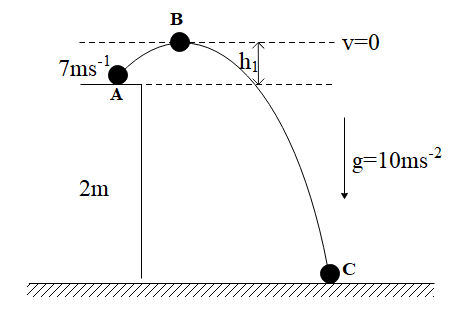Answer
384.9k+ views
Hint: We shall analyze the velocity of the object at various points of its motion and apply the equations of motion at those points. However, before applying the equations of motion, we will first break down the journey of the object into two parts.
Complete answer:
We have marked three points in the journey of the object that are A, B and C respectively. Also, we break up the motion of the object into two parts, from A to B and from B to C.

We shall first look into the motion of the object from A to B.
At point A, the object has an initial velocity of $7m{{s}^{-1}}$. When it is thrown vertically, it does not fall downwards directly rather it goes upward to reach its maximum height. At the maximum height, the velocity of the object is zero. Thus, the acceleration acting on it is negative of the acceleration due to gravity, that is,$-10m{{s}^{2}}$. Let the time taken to complete this journey be ${{t}_{1}}$.
Applying the equation of motion, $v=u+at$ and substituting values, $v=0m{{s}^{-1}},u=7m{{s}^{-1}},a=-10m{{s}^{-2}},t={{t}_{1}}$, we get
$\Rightarrow 0=7+\left( -10 \right){{t}_{1}}$
$\Rightarrow 10{{t}_{1}}=7$
Dividing both sides by 7, we get
$\Rightarrow {{t}_{1}}=\dfrac{7}{10}s$
Also, ${{h}_{1}}=\dfrac{{{v}^{2}}-{{u}^{2}}}{2a}$
$\begin{align}
& \Rightarrow {{h}_{1}}=\dfrac{0-{{7}^{2}}}{2\left( -10 \right)} \\
& \Rightarrow {{h}_{1}}=\dfrac{49}{20}m \\
\end{align}$
$\Rightarrow {{h}_{1}}=2.45m$
Now, when the object travels from point B to C, the object is freely falling under the force of gravity from its maximum height. Applying the equation of motion, $s=ut+\dfrac{1}{2}a{{t}^{2}}$ and substituting the values, $s=2m+{{h}_{1}},u=0m{{s}^{-1}},a=10m{{s}^{-2}},t={{t}_{2}}$ , we get
$\Rightarrow 2+2.45=\left( 0 \right){{t}_{2}}+\dfrac{1}{2}\left( 10 \right)t_{2}^{2}$
$\Rightarrow 4.45=5t_{2}^{2}$
$\Rightarrow {{t}_{2}}=\sqrt{\dfrac{4.45}{5}}s$
Thus, the total time of motion of the object is ${{t}_{1}}+{{t}_{2}}$.
$\begin{align}
& \Rightarrow t=\dfrac{7}{10}+\sqrt{\dfrac{4.45}{5}} \\
& \Rightarrow t=0.7+0.94 \\
\end{align}$
$\Rightarrow t=1.64s$
Therefore, time taken for the object to hit the ground is 1.64 seconds.
Note:
In motion from A to B, we have taken the acceleration of the object as negative of acceleration due to gravity because it is going in the exact opposite of the acceleration due to gravity. However, in motion from B to C, we have taken the acceleration to be positive acceleration due to gravity because then the object is moving in the same direction as that of the acceleration due to gravity.
Complete answer:
We have marked three points in the journey of the object that are A, B and C respectively. Also, we break up the motion of the object into two parts, from A to B and from B to C.

We shall first look into the motion of the object from A to B.
At point A, the object has an initial velocity of $7m{{s}^{-1}}$. When it is thrown vertically, it does not fall downwards directly rather it goes upward to reach its maximum height. At the maximum height, the velocity of the object is zero. Thus, the acceleration acting on it is negative of the acceleration due to gravity, that is,$-10m{{s}^{2}}$. Let the time taken to complete this journey be ${{t}_{1}}$.
Applying the equation of motion, $v=u+at$ and substituting values, $v=0m{{s}^{-1}},u=7m{{s}^{-1}},a=-10m{{s}^{-2}},t={{t}_{1}}$, we get
$\Rightarrow 0=7+\left( -10 \right){{t}_{1}}$
$\Rightarrow 10{{t}_{1}}=7$
Dividing both sides by 7, we get
$\Rightarrow {{t}_{1}}=\dfrac{7}{10}s$
Also, ${{h}_{1}}=\dfrac{{{v}^{2}}-{{u}^{2}}}{2a}$
$\begin{align}
& \Rightarrow {{h}_{1}}=\dfrac{0-{{7}^{2}}}{2\left( -10 \right)} \\
& \Rightarrow {{h}_{1}}=\dfrac{49}{20}m \\
\end{align}$
$\Rightarrow {{h}_{1}}=2.45m$
Now, when the object travels from point B to C, the object is freely falling under the force of gravity from its maximum height. Applying the equation of motion, $s=ut+\dfrac{1}{2}a{{t}^{2}}$ and substituting the values, $s=2m+{{h}_{1}},u=0m{{s}^{-1}},a=10m{{s}^{-2}},t={{t}_{2}}$ , we get
$\Rightarrow 2+2.45=\left( 0 \right){{t}_{2}}+\dfrac{1}{2}\left( 10 \right)t_{2}^{2}$
$\Rightarrow 4.45=5t_{2}^{2}$
$\Rightarrow {{t}_{2}}=\sqrt{\dfrac{4.45}{5}}s$
Thus, the total time of motion of the object is ${{t}_{1}}+{{t}_{2}}$.
$\begin{align}
& \Rightarrow t=\dfrac{7}{10}+\sqrt{\dfrac{4.45}{5}} \\
& \Rightarrow t=0.7+0.94 \\
\end{align}$
$\Rightarrow t=1.64s$
Therefore, time taken for the object to hit the ground is 1.64 seconds.
Note:
In motion from A to B, we have taken the acceleration of the object as negative of acceleration due to gravity because it is going in the exact opposite of the acceleration due to gravity. However, in motion from B to C, we have taken the acceleration to be positive acceleration due to gravity because then the object is moving in the same direction as that of the acceleration due to gravity.
Recently Updated Pages
How many sigma and pi bonds are present in HCequiv class 11 chemistry CBSE

Why Are Noble Gases NonReactive class 11 chemistry CBSE

Let X and Y be the sets of all positive divisors of class 11 maths CBSE

Let x and y be 2 real numbers which satisfy the equations class 11 maths CBSE

Let x 4log 2sqrt 9k 1 + 7 and y dfrac132log 2sqrt5 class 11 maths CBSE

Let x22ax+b20 and x22bx+a20 be two equations Then the class 11 maths CBSE

Trending doubts
Fill the blanks with the suitable prepositions 1 The class 9 english CBSE

At which age domestication of animals started A Neolithic class 11 social science CBSE

Which are the Top 10 Largest Countries of the World?

Give 10 examples for herbs , shrubs , climbers , creepers

Difference between Prokaryotic cell and Eukaryotic class 11 biology CBSE

Difference Between Plant Cell and Animal Cell

Write a letter to the principal requesting him to grant class 10 english CBSE

Change the following sentences into negative and interrogative class 10 english CBSE

Fill in the blanks A 1 lakh ten thousand B 1 million class 9 maths CBSE



